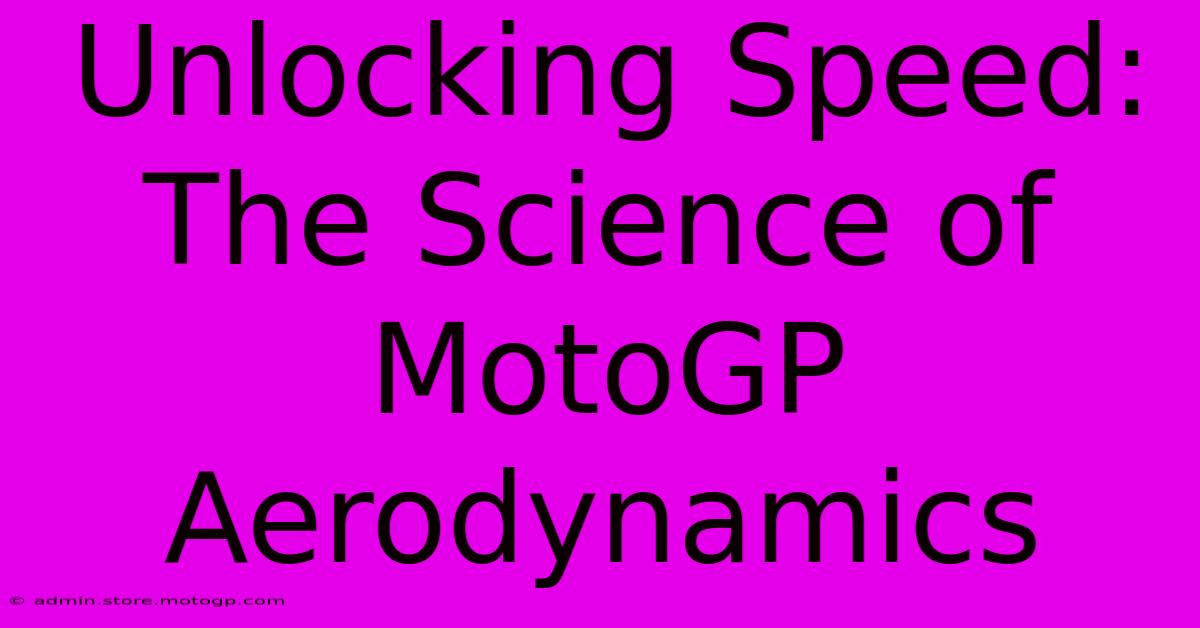Unlocking Speed: The Science Of MotoGP Aerodynamics

Table of Contents
Unlocking Speed: The Science of MotoGP Aerodynamics
MotoGP. The pinnacle of motorcycle road racing. The roar of the engines, the breathtaking speeds, the hair-raising overtakes – it’s a spectacle of skill and technology. But beyond the rider's talent lies a crucial element often overlooked: aerodynamics. Understanding the science behind MotoGP aerodynamics is key to appreciating the incredible speeds these machines achieve. This article dives deep into the intricate world of wind tunnels, downforce, and drag reduction, exploring how these factors contribute to the ultimate racing performance.
The Physics of Speed: Drag and Downforce
At the heart of MotoGP aerodynamics lies the fundamental interplay between drag and downforce. Drag is the resistance a motorcycle encounters as it moves through the air. Reducing drag is paramount for achieving higher top speeds. Downforce, on the other hand, is the force that pushes the motorcycle towards the track, enhancing grip and allowing for faster cornering speeds. The optimal balance between these two opposing forces is the holy grail of MotoGP engineering.
Minimizing Drag: The Pursuit of Slipperiness
Minimizing drag involves meticulous design of every component. Think streamlined fairings, carefully sculpted bodywork, and aerodynamic wings strategically positioned to manage airflow. Even small details, like the shape of the mirrors or the design of the exhaust system, can have a significant impact on overall drag. Teams employ advanced Computational Fluid Dynamics (CFD) simulations and wind tunnel testing to refine these designs, shaving off precious milliseconds from lap times.
Maximizing Downforce: Sticking to the Track
Generating downforce is equally crucial. Unlike cars, motorcycles rely heavily on aerodynamic devices to achieve this. Winglets, those small, wing-like appendages found on the fairings, are crucial in generating downforce, especially at high speeds. They're designed to manipulate airflow, creating a pressure difference that pushes the motorcycle downwards. The placement and angle of these winglets are constantly optimized, resulting in remarkable improvements in cornering stability and speed.
The Role of Wind Tunnels and CFD
The development of cutting-edge MotoGP aerodynamics wouldn't be possible without sophisticated testing methodologies. Wind tunnels are essential for evaluating the performance of different designs under controlled conditions. Engineers meticulously analyze airflow patterns around the motorcycle, identifying areas for improvement. Computational Fluid Dynamics (CFD) simulations provide a virtual testing ground, allowing for faster and cheaper iteration of design concepts before physical prototypes are created. This combined approach ensures that every aerodynamic element is optimized for maximum performance.
The Ever-Evolving Landscape of MotoGP Aerodynamics
The world of MotoGP aerodynamics is in a constant state of evolution. Regulations change, pushing teams to find innovative solutions. New materials and manufacturing techniques are continuously being explored to further refine designs and improve performance. The competition is fierce, and the quest for aerodynamic perfection drives innovation at an unrelenting pace. This ongoing arms race ensures that the speeds and excitement of MotoGP continue to push the boundaries of what's possible.
Conclusion: A Symphony of Speed and Science
The incredible speeds achieved in MotoGP are not solely a result of powerful engines. They are a testament to the intricate science of aerodynamics. The interplay of drag reduction and downforce generation, meticulously honed through advanced technology and rigorous testing, is what allows these machines to achieve breathtaking speeds and thrilling performances. Understanding this science enhances our appreciation of the complex engineering marvel that is MotoGP. The next time you witness the spectacle, remember the unseen forces at play, silently working to unlock the ultimate speed.

Thank you for visiting our website wich cover about Unlocking Speed: The Science Of MotoGP Aerodynamics. We hope the information provided has been useful to you. Feel free to contact us if you have any questions or need further assistance. See you next time and dont miss to bookmark.
Featured Posts
-
Moto Gp Sprint The New Face Of Moto Gp
Feb 17, 2025
-
Moto Gps Most Modern Tracks State Of The Art Racing
Feb 17, 2025
-
Moto2 Bike Specs Understanding The Basics
Feb 17, 2025
-
Moto Gp Replay The Perfect Way To Share The Excitement
Feb 17, 2025
-
Invest In Speed Racing Motorcycles For Sale
Feb 17, 2025
